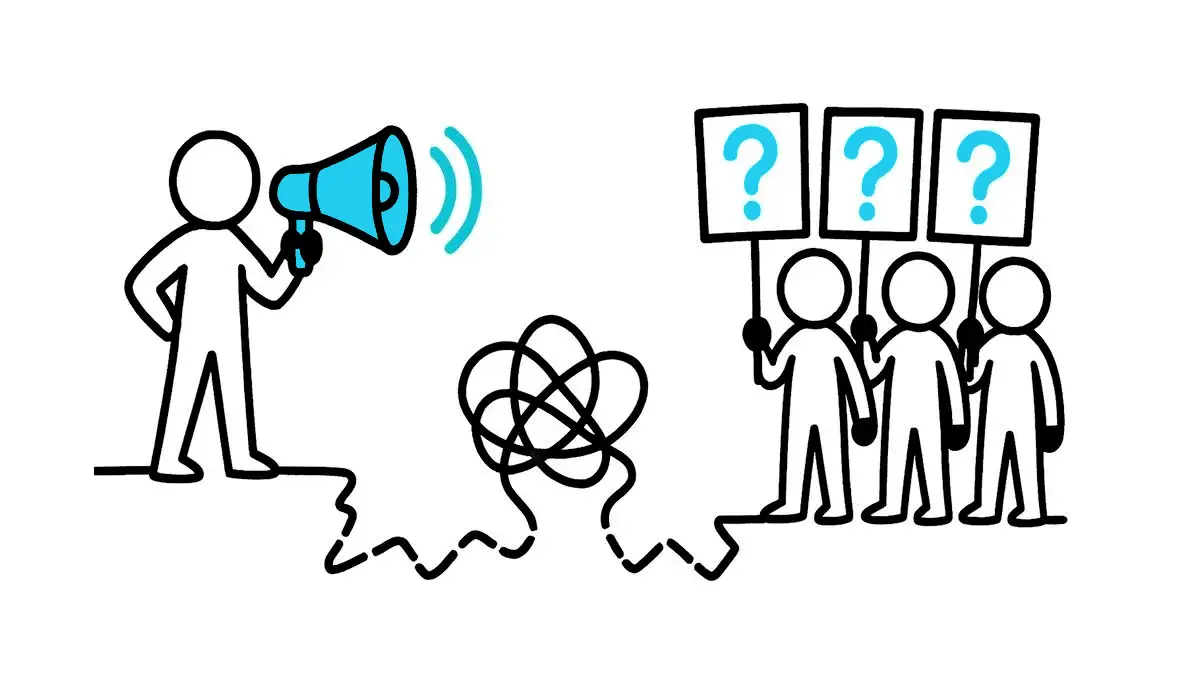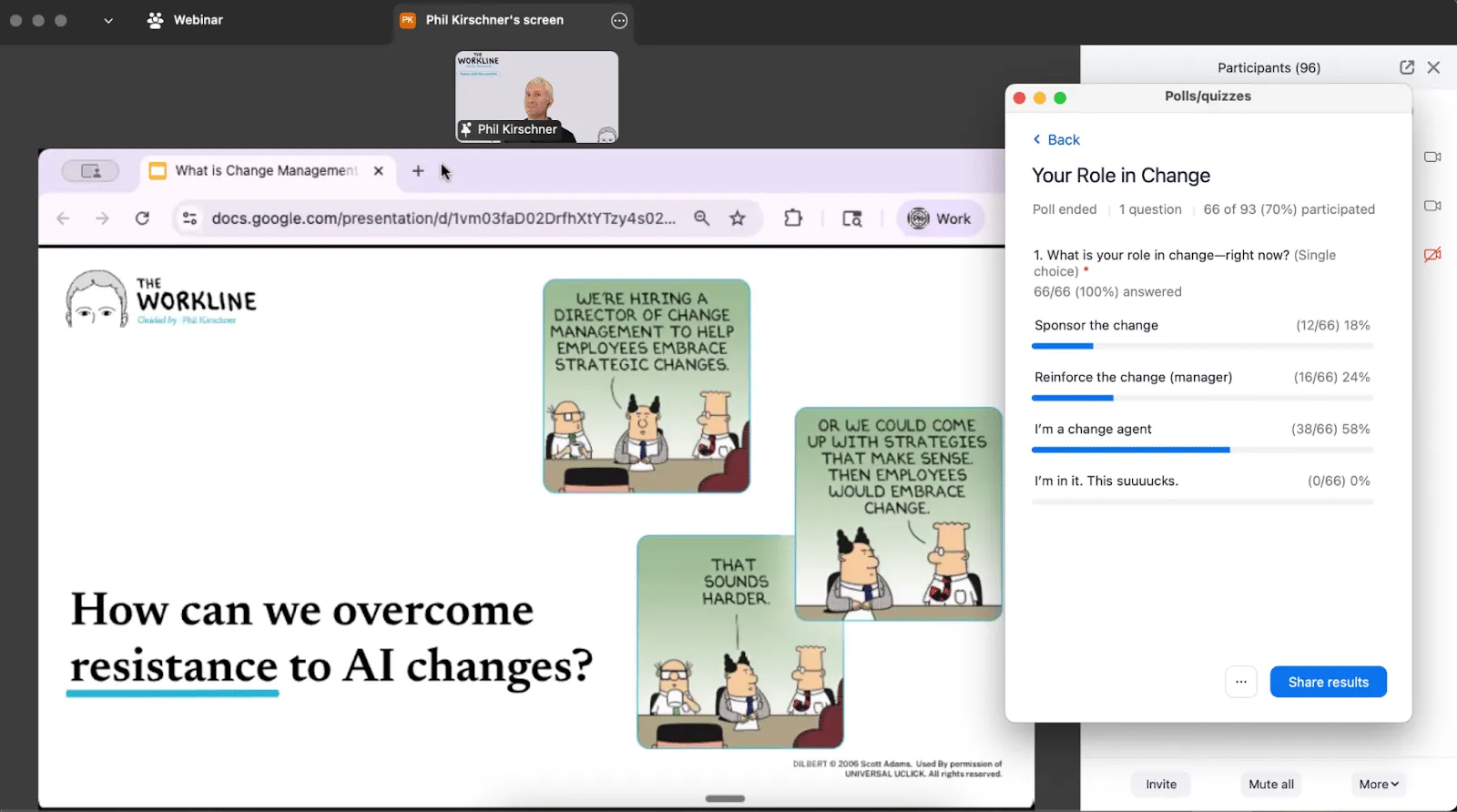Define the Change or Watch it Fail [Free List of 40+ Questions]

Charter’s New Employer Brand Summit reminded me how critical leadership communication is for companies seeking to retain top talent.
Daniel Zhao, Lead Economist at Glassdoor, shared that employees were very positive about executive communications during the pandemic lockdown because their leaders were more authentic and more vulnerable. They had to be human in the face of a harrowing situation.
Around that time, I served a financial services firm whose CEO wanted to reimagine the employee experience. His most powerful move? Admitting he didn't know the answer, only that something needed to change.
But as Zhao pointed out, the candor is fading:
Employees are like, ‘Where is the leader that I was talking to during COVID-19 who was willing to be more transparent?’
In today’s unpredictable world (Hello, hybrid work!), employees aren’t just asking what’s changing—they want to know why, who decided, and what it really means for them. When leaders communicate a change, people impacted expect more than headlines. They want the messy details.
The first step in a successful change program is establishing a “North Star” vision. Next, define the change you are about to lead.
Most companies fail to draw clear lines between what's changing and why, leaving employees to fill in the blanks with mistrust, fear, and assumptions.
An egregious example from two years ago is below.

Lead Across the Lines of Modern Work with Phil Kirschner
Over 22,000 professionals follow my insights on LinkedIn.
Join them and get my best advice straight to your inbox.
What "Define the Change" Means
Many leaders assume everyone knows what's changing. They often don’t, even when legions of thought leaders and analysts try to decipher hidden messages in corporate announcements.
The gap between executive understanding and employee confusion is where transformation fail. Dozens of change management methodologies offer specific approaches to closing the gap.
The two frameworks I see most frequently on job descriptions and resumes are PROSCI’s ADKAR Model and Kotter’s 8-Step Model.
- PROSCI defines change by mapping exactly what each person must do differently in their day-to-day work. It's behavioral: "Marketing will use HubSpot instead of Excel for lead tracking."
- Kotter lives at the organizational level and defines change through vision and momentum: "We will be more data-driven." (Fun Fact: The adage “70% of change programs fail to achieve their goals” is widely attributed to John Kotter.)
I am personally certified in the LaMarsh Managed Change methodology, which defines change by mapping the shift from current state to future state, and assessing resistance from specific target groups. "What habits make Marketing not want to stop using Excel, and how do we remove them?"

Back to the Marketing example, a LaMarsh practitioner might ask, “What habits or dependencies make Marketing not want to stop using Excel, and how do we remove them?”
My LaMarsh mental model informs my passion for understanding and mitigating resistance to change.
No matter the framework, the more precisely you define the why, who, where, when, and what of a change, the less resistance you'll encounter.
The most successful transformations start with ruthless clarity about "the Five W's" across three ascending levels of complexity. Basic descriptions are below; read to the end for a free list of 40+ questions you can use right now.

Fix Your AI Fears!
Missed my webinar on AI rollout change resistance? Get the replay, presentation, and resources here!
Level 1: Change Basics
The first step is charting your course. Start with basics that everyone should be able to answer, even if they're not directly involved in the change.
- WHY is this change happening? Begin with the business case. What's not working today? Why now rather than six months ago?
- WHO is driving this change? Name names. Who made the decision? Employees can sense when leadership isn't aligned.
- WHERE is the change taking place? Physical locations matter, but so do organizational and technical boundaries. One business unit? One floor? All systems?
- WHEN is this happening? Set clear timelines. When will people be notified? What are the critical milestones?
- WHAT is changing? List the tangible differences people will experience. New tools, different processes, changing reporting structures, etc.
Answering these foundational questions should only take 10-15 minutes. If you can't manage that, perhaps you're not ready to announce this change.
Level 2: Hidden Friction
Once you've nailed the basics, dig deeper into the forces that will determine success or failure...especially when you encounter rough seas.
- WHY now, and what if we fail? What external pressures are creating urgency? What happens if the change is delayed? Make the changes feel necessary rather than optional.
- WHO has the power to make or break this? Who will determine if the change is successful? Map your stakeholder influence before you need it.
- WHERE are the ripple effects? Will this change affect client interactions, partner relationships, or supply chains?
- WHEN do we know it's working? How long will the targets stay in the new state? Are other changes happening concurrently that could derail progress? Define metrics to identify warning signs.
- WHAT are we not changing? What aspects are negotiable, and by whom? Prevent endless debates about settled decisions.
Level 2 questions require stakeholder input and several hours of discussion.
Level 3: Long-Term Transformation
The deepest level is about human and business dynamics for long-term success.
- WHY does this change help the business? How will performance and success be determined? Connect the change to measurable business outcomes and cultural aspirations.
- WHO will sustain this change over time? Who will monitor the change to ensure course corrections are made? Changes fail when there's no clear ownership after implementation.
- WHERE does this fit in our broader strategy? Is this a strategic shift in the business? How does it relate to other transformations? Employees need to see the bigger picture.
- WHEN will we know the change is complete? How will employees know when we have reached the desired future state? The journey never ends if you have not clearly defined a destination.
- WHAT skills and behaviors need to evolve? What will it take (e.g., policies, competencies, responsibilities) to sustain the change? How will future employees know how to follow new norms?
Level 3 requires extensive collaboration and could take weeks of iteration. You don't need all answers up front, just show employees you're working on them.
🎙️ Phil's Content and Connections 🎥
I was recently on two podcasts:
- Rex Miller's Resilience Lab
- Al Dea's The Edge of Work
I have two public conference keynotes in the Fall:
- WorkSpaces on October 5-7 in Napa
- Tradeline on October 23 in San Diego
Putting It All Together
Here is an oversimplified example of a clearly defined change in practice:
- The Change: "We're replacing weekly status meetings with async video updates to reclaim 5 hours per week for deep work."
- Level 1: SVP Mary decided after time audit showed 60% of meetings lack clear outcomes. Department heads lead adoption. All recurring status meetings under 30 minutes switch to video by month-end.
- Level 2: Managers fear losing oversight; success means 80% prefer async format within 60 days, or we revert to meetings.
- Level 3: Enhances flexibility across time zones; Leaders model vulnerability in recordings, IT provides training, HR updates performance reviews to evaluate async skills.
Again, this version is artificially short, but you can see how each level builds specificity while addressing different stakeholder concerns.
Where to Start [Free Guide Below]
The three-level framework isn't about having every answer. It's about defining what you know, what you don't, and how you'll collaborate to figure it out.
Your next move depends on where you are:
- Planning a change? Start with Level 1. If you can't answer them quickly, go back to the “North Star” drawing board.
- Mid-transformation? Audit your communication against all three levels. Fix the definition before fighting the resistance.
- Fighting change fatigue? Use this framework to distinguish transformational changes from tactical adjustments.
In today's business environment, change is constant. Leading organizations embrace a change mindset to develop their people alongside their strategy.
As Katie Burke, Chief People Officer at Harvey, reminds us:
Instead of promising certainty, what I can tell you is the seas might stay choppy, but we're going to make you a great sailor.
You can't control the storms, but you can teach your crew to navigate them with resilience. The clearer your change definition (including what you don't know), the better equipped your people will be to sail through it successfully.
Which level of definition does your current change need? Can you answer all those questions? Please get in touch to tell me about the transformation you're currently navigating.
- Phil

Lead Across the Lines of Modern Work with Phil Kirschner
Over 22,000 professionals follow my insights on LinkedIn.
Join them and get my best advice straight to your inbox.


